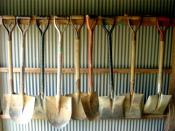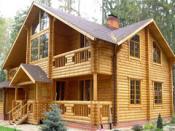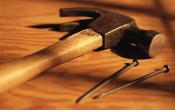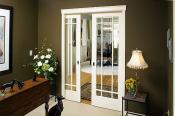Search
Login
Self-leveling floors and screeds
The ability of the finished mixture to self-level is a bulk floor. Details about the methods of pouring and the types of bulk floors will be discussed in this article.
Content
- Coupler - a source of development of a bulk floor
- Three types of screeds video
- Bulk floor
- Dry screed video
- Semi-dry screed video
- Types of bulk floors
- Bulk floor - the main floor (advantages and disadvantages)
- Technology for laying bulk floors
Coupler - a source of development of a bulk floor
In Europe, at the end of the 13th - the beginning of the 14th century, parquet began to be laid. The result of the operation of the parquet showed: in order for the parquet to lie well and for a long time, the surface under it should be flat, strong and not allow moisture to pass through. So the first screed was born, originally it was made of wood.
In Russia, in the 17th century, parquet began to be laid on a lime base.
Modern houses are multi-unit and are built of concrete. The floor in the apartments is a concrete slab. This slab for one apartment is a ceiling, for the other floor, concrete slabs are made even on only one side - from the ceiling.
The floor of such a plate is an uneven surface with tubercles and pits.
It is not possible to lay the flooring on such a surface. Preliminary leveling is necessary, it is achieved by the fact that a special mixture is distributed on the surface of the concrete slab, the use of which allows you to get a flat surface for the finishing decorative coating.
Decorative coating can be anything: linoleum, parquet, granite.
But for any of them you need a screed, i.e. leveling layer between the concrete slab and the finishing decorative coating.
Three types of screeds
By type of astringent, screeds are cement, gypsum and magnesia.
For private housing, the first two types are mainly used.
For wet rooms, apply materials on a cement binder.
For dry rooms - on cement and gypsum binders.
Materials on magnesia binders, used for special types of floors.
According to the interaction with the concrete slab, there are three types of screeds.
The first - those that are in direct contact with the concrete slab, form a single whole (mortar - slab).
The second - between the screed and the concrete slab, a separation layer is laid in the form of a polyethylene film, roofing felt or waterproofing is made with polymer mastics.
Third - floating screeds on a sound - or heat insulating layer. This solution is placed on foam or on a plate of high density mineral wool.
Depending on the condition of the base of the floor, the operating conditions of the finish coating, the type of screed is also selected.
Since each of the coatings has its own thickness, it must be taken into account when determining the height of the proposed screed.
For example, porcelain tile - 7-9 mm. plus tile adhesive thickness 2-4mm .; laminate - 8-12 mm .; parquet - 14-18 mm. plus substrate; linoleum - 2-3 mm.
Bulk floor
The ability of the finished mixture to self-leveling, gave the name - bulk floor.
After preparing the mixture, it is poured onto a prepared, cleaned base, it spreads over the entire surface. It is leveled with a rubber spatula, and in order to get rid of air in the thickness of the mixture, it is rolled with a needle roller.
With proper observance of technology, bulk floors should independently be aligned to a perfectly horizontal plane. This floor dries faster than a conventional screed, its thickness can be very small, about 25 mm.
-
Small thickness is extremely important for apartments with low ceilings.
-
For additional noise and heat insulation, a layer of expanded polystyrene can be laid under the bulk floor, for additional waterproofing, a polymer film can be laid on top.
-
On the bulk floor in the apartment, you can lay tiles, carpets and linoleum.
-
To lay the parquet, it is necessary to lay plywood on the bulk floor.
-
When making the floor in apartments, you can choose a combined option: first, put the usual screed in the form of concrete mixture, and after solidification with the second layer, the bulk floor is made.
-
After solidification of the bulk floor, it is necessary to lay waterproofing from bitumen or rubber mastic.
-
Plywood is laid on the waterproofing, and then the finish floor.
-
You can do without plywood if you are laying tiles.
-
This floor will cost more, but it will last longer and get better.
Dry screed
Dry screed is carried out using gypsum-containing boards, it is necessary to lay a waterproofing coating on it. Alignment is carried out due to dry filling or polystyrene, the plates are overlapped.
Such a dry screed has advantages: it does not need to dry, the finish floor can be laid the very next day, the flooring is much easier than any mixture, since for an apartment of 100 square meters, the weight of the concrete screed will be about 7 tons.
Dry screed has one drawback, it is afraid of moisture, in a multi-apartment building there is a danger that neighbors will flood you.
Semi-dry screed
When using water in the smallest amount, just to ensure hydration of the cement - this is a semi-dry screed.
Due to the dense tamping during laying and a small amount of water, such a floor practically does not shrink.
For such a floor, appropriate equipment is needed, this method is used by builders when they rent finished apartments throughout the house.
Types of bulk floors
If the floor is subjected to heavy load, use epoxy or polyurethane floors. Such floors are used for administrative or commercial premises.
When installing the floor in apartments, they use gypsum or cement-based floors, polyurethane floors are widely used, ceramic tiles, parquet, laminate, linoleum or warm floors are laid on top.
By the type of polymers included in the bulk floors, the following classification is performed:
the first is polyurethane,
the second is epoxy
the third is epoxy-polyurethane,
the fourth is methyl methacrylate,
fifth - cement-acrylic.
Polyurethane coating, used for the home, in which the bulk floor will be at the same time and the finish.
Polyurethane bulk floors are the most flexible, have good impact resistance, are resistant to concrete cracking, and are suitable not only for home but also for industrial use.
The remaining bulk floors are used for industrial premises. Methyl methacrylate floors are not afraid of freezing temperatures.
Epoxy-polyurethane bulk floors are used in garages, parking lots, etc.
Epoxy bulk floors can withstand extreme heat, up to +50 degrees Celsius.
Bulk floor - the main floor (advantages and disadvantages)
In order for the bulk floor to become the main one, you must first prime the concrete base with a polyurethane or epoxy primer. Then the selected coating is applied in two layers, polyurethane enamel or epoxy compound can be used, but both layers must consist of the same mixture.
The front layer is applied after decorating the coating, using the same material as in the coating before decorating.
Disadvantages: such a bulk floor may turn yellow under direct sunlight.
Advantages: requires less cost, you can immediately fill a large surface, remove the joints between the rooms.
You can make photo printing on a special film, it is placed under a transparent bulk floor. Thus, 3D floors are obtained.
Depending on your imagination, the floor may look like a flowering meadow, ocean depths, etc.
Now in modern construction, the developer often applies modern technologies, for example, apartments in a balashikha in a new building meet all the requirements of modern design. The quality of the decoration of the apartment is amazing. Magnificent walls, high-quality flooring, such a floor will be very difficult to change, since good flooring lasts a very long time, everything is at the highest level.
Technology for laying bulk floors
The initial surface is cleaned of dust, grease stains and other contaminants. A primer is applied to the base, it will close the cracks in the concrete - it is dried for two hours.
On the perimeter, along all vertical surfaces with which the bulk floor will come into contact, stick a damper tape, this will protect the drying surface from cracking.
The bulk floor is leveled to a clear horizontal, but for safety reasons it is recommended to install beacons. Their accuracy should be checked using a level or level.
After the primer has dried, the solution of the self-leveling floor is prepared.
According to the recommendations specified in the instructions for the mixture, the selected mixture is poured into a container of water. Using an electric mixer at low speeds, the composition is stirred until smooth. Stir for no more than five minutes, then the mixture is left alone for five minutes and again stirred.
The result should be a mixture without lumps. Exactly follow the instructions if you pour water - this will lead to delamination of the mixture and a decrease in its strength.
After the solution is ready, it is poured onto the surface, you can use the pump. Using a roller on a long handle or a spatula, distribute the liquid on the surface, bring it to all corners of the room.
Using a needle roller, after each portion of the fill, air bubbles are removed. The pouring thickness should be at least 30 mm., If the base on which the coating is laid is weak. The floor should now harden.
It is necessary to exclude drafts and the effect of direct sunlight on not yet hardened material.
The packaging indicates when it will be possible to walk on the surface.
The thickness of the coating also affects this; ceramic tiles or porcelain stoneware can be laid in just three days.
If you want to lay the parquet, you can lay it no earlier than seven days later.
Depending on the type of bulk floor, its thickness, humidity of the coating and the manufacturer's instructions, the numbers also change.





